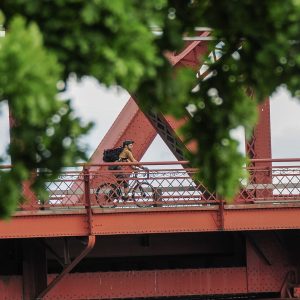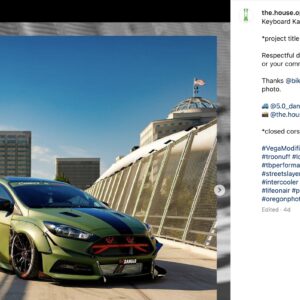
In case you haven’t heard, a bridge on Interstate 5 north of Seattle collapsed and toppled into the Skagit River last night. Two cars fell into the river but amazingly no one was seriously hurt. Reports say it was caused when a large semi truck hit a steel beam truss which caused the bridge to wobble and then crack.
Almost immediately, folks wondered how this eye-popping infrastructure failure would impact the discussion around the Columbia River Crossing project. And almost immediately, the spin began from the pro-CRC side. Here’s a snip from a Portland Tribune story posted this morning:
The collapse of the I-5 bridge over the Skagit River in Washington highlights the need to invest more in transportation infrastructure, say supporters of the Columbia River Crossing project.
“We’re glad no one appears to have been seriously hurt, but it shows the need to invest in our transportation infrastructure, like the I-5 bridge over the Columbia,” says Portland Business Alliance official Megan Doern, a spokesperson for the Columbia River Crossing Coalition, which supports the project.
It seems absurd that this news would strengthen the case for the CRC. That project would spend $3.6 billion on five miles of new freeway lanes, six widened interchanges, and a massive new bridge. And it’s worth noting that — despite attempts at convincing everyone the CRC is a “bridge project” — the actual bridge replacement portion of the project represents just 30% of the entire budget.
If anything, this bridge collapse should remind us of how ridiculous it is to keep pouring billions into new highway projects while existing infrastructure gets worse and worse.
Transportation For America, a national non-profit that has advocated for more funding of deficient bridges and aging infrastructure, is already on the case and they’re expected to make a more formal statement later today (UPDATE: here it is).
Suffice it to say it will be interesting to see how this high-profile event is spun by both sides.
UPDATE:
Bridge collapse doesn’t sway CRC opponents – The Columbian
Skagit River Interstate 5 bridge collapse could cause Washington legislators to fund Columbia River Crossing – The Oregonian







Thanks for reading.
BikePortland has served this community with independent community journalism since 2005. We rely on subscriptions from readers like you to survive. Your financial support is vital in keeping this valuable resource alive and well.
Please subscribe today to strengthen and expand our work.
My second thought (after worrying about people being hurt) was how this would affect Washington’s media’s CRC stance.
It seems like it could be spun either way: “build this Vancouver to Portland bridge now, lest it also fall” or “this Vancouver to Portland bridge is draining resources from really needed projects, kill the project with fire.”
America is great at building stuff, not so great about maintaining stuff.
“Washington is in even worse shape. After years of denial, the state recently slashed long-term revenue forecasts by billions of dollars. But since the state back-loaded interest payments on many of its highway bonds, its debt obligations will rise even if fuel tax receipts dip. Within just a few years, more than 70 percent of the state’s gas tax receipts will go to pay off debts on projects that have already been completed—leaving precious little gas tax revenue for maintenance of existing roads, let alone new construction.” (emphasis mine)
http://bikeportland.org/2013/05/14/report-end-of-driving-boom-requires-a-new-direction-86720#comment-4019833
That’s why the studded tire iniative preserving our roads is money in the bank
Jeff
I am in a serious bet with a friend that the CRC gets approved now!
Jonathan
I don’t believe the bridge was structurally deficient. The bridge was classified as structurally obsolete, which means the clearances and lane widths are not upto current standards. The bridge appears to have taken a fatal blow from a truck too large to safely cross it.
Talk about a bad day at the office…
Some comments to O-live’s stories about the bridge collapse apparently are quoting from some official sources that also describe the bridge as having been ‘structurally obsolete’. That description can mean various things. Not that the bridge was imminently in danger of falling down on its own, but that it wasn’t up to today’s transportation needs. Also old, are the CRC bridges, a factor which naturally raises questions about the structural integrity of any bridge.
About the existing CRC’s structural integrity, it’s worth a review here in comments to this story, of what that integrity is for those bridges. Inevitably, someone will bring up the old story that the CRC is resting on rotting timber pilings, and that any day now, the bridge could collapse because of them. Refreshing memory on what the actual situation is, can help still anxiety over uncertainty on that issue.
Be interesting to see if Wash DOT goes after the trucking company for the cost of replacing the bridge. I doubt their insurance policy will cover that bill.
“Structurally obsolete” could mean “designed in such a way that a single oversized load could take the whole thing down”.
“If anything, this bridge collapse should remind us of how ridiculous it is to keep pouring billions into new highway projects while existing infrastructure gets worse and worse.”
This. You could bring a lot of lesser bridges up to structural standards for the cost of replacing a bridge that’s in perfectly serviceable condition.
Our short statement is indeed up if you’re interested. Thanks for the shoutout Jonathan!
http://t4america.org/pressers/2013/05/24/tragic-bridge-collapse-in-washington-highlights-urgent-problem-of-aging-and-deficient-us-bridges/
a truck carrying a massive load hit and damaged a key structural girder.
If anything, this highlights how destructive motor vehicle traffic can be.
One such accident considering what must have been hundreds of millions of vehicles passing over that bridge is a pretty good record.
I just drove over that bridge earlier this week!
Hopefully they can replace it with a bridge with wider shoulders so it will finally be legal to bike over (it was the only spot on I-5 from Marysville to Bellingham prohibited to bikes).
Previously, due to the lack of shoulders on the now collapsed I-5 bridge, cyclists on I-5 are required to exit on either end of the bridge and make a detour that adds at least half a mile to what would only have been a mile, along with adding nearly a dozen traffic lights to the route.
With the bridge out, and detours in place, everyone will now experience this same inconvenience.
When this bridge is hopefully replaced, I hope that the shoulders will be upgraded, providing added safety for motorists and added capacity for emergency vehicles, while also having the added benefit of allowing cyclists to safely continue along I-5 over the Skagit River.
This should weaken the case for the CRC. It definitely builds a case to replace the bridges spanning the Columbia, but most of the CRC is not going to do this. So yes, we should spend $1 billion to replace the existing I-5 bridges. The other $3 billion should be redirected to replace the dozens of other small bridges on the I-5 corridor that are in similar condition.
If the priority is safety, the CRC is the wrong project to support.
The I-5 replacement bridge is estimated at costing ~$400 million, not $1,000 million.
so many other things to consider.
The economic benefits of replacing existing bridges that can currently handle capacity versus a major bridge that restricts commerce.
“If anything, this bridge collapse should remind us of how ridiculous it is to keep pouring billions into new highway projects while existing infrastructure gets worse and worse.”
It’s also a little ridiculous to essentially argue that new projects dont replace and/or improve existing infrastructure.
JNE,
they don’t. Many/most new projects simply add capacity and/or widen existing facilities. I don’t think that always = an improvement.
Ironically, doesn’t the DOT term “highway improvement” actually mean adding lanes?
To be fair, the two current bridges under construction in Portland, don’t do either of these things for automobiles, and HIGHLY increase bike infrastructure.
To be fair, I doubt that ODOT refers to the pedestrian bridge under construction as a ‘highway improvement.’
the story I read said that the bridge was “fracture critical”, meaning that a large enough impact could bring the entire thing down…
I downloaded the data from fhwa.dot.gov and the column for FRACTURE_092A lists both the Skagit and Columbia bridges at Y24… I’m not sure what Y24 means but them having the same number to me means that they are at the same risk…
so if the Columbia bridge takes the same kind of hit then it could also fall into the water…
granted, if anything takes more force than it’s rated for, such as in this incident, then something bad is likely to happen… but CRC supporters will use fear and misinformation to rally their cause…
I would push back that the risk for the I-5 bridges is much lower, due to I-205. There are many low-clearance bridges on I-5 between Vancouver and Tualatin, so I-205 is the primary route for oversized trucks. There is no parallel freeway in Mount Vernon.
“Experts said fracture-critical bridges may have an alarming name, but they are structurally sound as long as proper inspections and maintenance are undertaken.”
http://www.democratandchronicle.com/article/20111023/NEWS01/110230330/bridges-New-York-state
“The equipment was said to be an oil-rig drilling piece. Sherbinski said the company received a permit from Washington state authorities that suggested the truck could safely navigate the bridge.”
http://www.globalpost.com/dispatch/news/regions/americas/united-states/130523/i-5-bridge-collapse-sends-cars-washington-river
So one fix to this “problem” would be for the State of Washington to not give permits to trucks that would drive parts of large oil rigs into the existing structures.
Classic. More externalities from our oil dependence: oil drilling rig needed to shore up our oil-saturated transportation infrastructure takes out bridge which we need to travel lickety-split in our oil-mobiles.
http://michaelklare.com/books/the-race-for-whats-left/
This was likely one truck of DOZENS that all incrementally wore down the structure of that bridge until the actual weight limit was lower than the previously assessed weight limit.
This could have been ANY over weight and/or over sized piece of freight, it just so happens that larger portions of that over sized freight is moving to support the recent hydrocarbon gold rush. There are hundreds of trucks carrying over weight and over sized freight on a daily basis passing through the I-5 corridor and Oregon each day. Some of them move parts of wind turbines or completed prefab buildings.
Obviously heavy road freight pays more per mile for use of public roads because they move more tonnage; over weight vehicles pay for permits to do so.
Perhaps the fee for that permit should be determined by an insurance company that charges the DOT for a sort of “catastrophic road/bridge replacement” policy. The heavier a load is the more likely a bridge would fail or other road system damage would occur. This would be charged to the DOT who would then pass that cost on to the freight haulers. This would have the effect of encouraging a reduction in extreme loading specs while insulating the taxpayer from massive emergency bonds to replace necessary infrastructure.
It didn’t fail from going over the weight limit, but because the cargo the truck was carrying struck an overhead beam that caused instantaneous structural failure of the bridge section the truck was on.
Of course, bridges with structural members UNDERNEATH the bridge deck aren’t vulnerable in that way, except to ships striking the underside.
Heck, a wayward airliner from PDX could run into the lift tower of the I-5 bridge and take it out as well! You never know what might happen.
Without spending huge amounts of money on engineering to proof infrastructure against any kind of risk, this is always possible.
“Heck, a wayward airliner from PDX could run into the lift tower of the I-5 bridge and take it out as well! You never know what might happen.”
I suspect you’re joking. But it’s not all that fanciful.
“After a Northwest flight crew distracted by a laptop overshot their destination by 150 miles, the Federal Aviation Administration (FAA) advised air carriers to create and enforce policies that limit distractions in the cockpit and keep pilots focused on transporting passengers safely.”
http://www.distraction.gov/content/dot-action/regulations.html
I’m not joking, the current lift towers are actually intruding into the airspace of PDX and Pearson airport. Thats one of the major reasons that the proposed CRC bridge height is so low, and they are going to have to pay $250 million as “compensation” for the upriver heavy industrial manufacturers on the Washington side of the river.
I didn’t have a chance to read what caused this failure before I posted so I’ll just assume you are right.
I do like the idea of tying the cost of moving over sized freight permits directly to an insurance policy issued to DOTs as an investment hedge against inevitable failures.
Basically if unsafe and unusually damaging freight is allowed to run on public roads and bridges the private insurer would have no choice but to raise rates to break even; to compensate DOTs would have to restrict such freight, charge higher permit fees or simply absorb the extra cost.
Can you give us a real web site link where we can see this information?
There’s insurance, and then there’s “insurance”. The railroad got tired of their bridge being hit, so they installed a device that enforces the clearance limits: http://11foot8.com . Sort of an IQ test for truck drivers.
If we bicyclists would pay our fair share of transportation taxes, this bridge wouldn’t have been in such bad shape. The incremental wear and tear that our bikes cause on bridges is surely a leading cause of this failure.
Just imagine if that stoopidtall bicyclist had crashed into the girders! I’ll bet the whole thing would have come down right then and there.
build the new bridge without light rail and all of those extra ramps. You can always add more ramps later.
Please. If you are against the CRC, please go bike to Vancouver at rush hour. I dare you. It’s not very far.
Sorry, your decision to commit yourself to a slow slog through over crowded roads does not obligate the rest of us to lower our standard of living.
Just because us here in the “People’s Republic of Portland” actually care about our fellow human beings doesn’t mean y’all get to bleed our tax coffers dry and poison our air to legitimize your long distance commutes.
I’d wager 95% of the people on this site against the CRC don’t drive that span during rush hour.
I’d wager that any invading army thinks they will suffer more from NOT invading your country than if they don’t; this is the tacit justification for the looting, pillaging, killing and what not.
Notice that nowhere in that justification does the invading army give a SINGLE DAM about the fate those they are invading.
Road expansion IS NOT its own justification nor is it the ultimate sign of advanced civilization; it is a sign that we value commute time and the pungent smell of asphalt and exhaust over clean air and safe streets.
I’d wager that a substantial portion who now drive the current bridge during rush hour (and with no passengers!) would find another option if the (current) bridge were tolled–and I don’t just mean the I-205 bridge either. Just because lots of people do something doesn’t mean our public policy should automatically cater to that behavior, or spend billions to encourage it.
Lots of people who don’t want their kids to be offered fast food in schools don’t eat at McDonalds either.
Next time you travel through Centralia, take a look at the southbound bridge over the Skookumchuck River. You can see the overhead damage from a similar impact.
Vintage cars need somewhere to drive though!!!